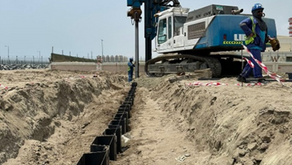Steel versus Vinyl Sheet Piles
- Mar 27, 2022
- 3 min read
INTRODUCTION
Earth retaining structures are usually found in various building and infrastructure projects. These are used for temporary excavation protection for buildings, and permanent retaining walls and floodwalls, depending on the nature of the project. Sheet piles are earth retaining structure components that can be used for both temporary and permanent applications. Sheet piles can be produced using different materials and can be formed into various cross sections (e.g., U and Z sections).


In this week’s blog, ESC will give an overview of the two commonly used materials for sheet pile manufacture. These are the (1) steel, and (2) vinyl sheet piles. Key similarities and differences will be discussed between these two types of sheet piles, each with its own advantages and disadvantages.
STEEL SHEET PILES
Steel sheet piles are the more common of the two sheet pile materials discussed in this article. This is one advantage over vinyl sheet piles, as steel sheet piles are more accessible to clients/ end-users. Sheet pile suppliers and manufacturers usually keep a stock of steel sheet pile sections that are mostly purchased.

Steel sheet piles are used as part of an earth retaining system, and have been proven to be effective and safe in resisting various design loads. Steel, as compared to vinyl/PVC, has a higher yield strength, usually ranging from 248.0 MPa (36.0 ksi) to 345.0 MPa (50.0 ksi). The higher yield strength from steel enables the sheet piles to carry larger design loads. The design loads that a sheet pile wall resists are generally magnified due to seismic effects and can control the appropriate sheet pile section to be installed at the site.

Steel sheet piles generally have higher values for section modulus, making them more applicable in retaining soil of a larger depth/height. Having high section modulus values also poses less problems in terms of sheet pile installation. The larger cross-sectional area and moment of inertia, in combination with higher yield strength enables the steel sheet piles to be driven into hard strata without incurring significant damage at the pile toe.
Steel sheet piles have a disadvantage compared to vinyl/PVC sheet piles, and that is its corrosive nature. When installed in marine environments, steel tends to corrode. In order to counteract the corrosion of steel sheet piles, protective coatings, and cathodic protection systems are installed. Such protective measures will prevent thinning of the sheet piles, and prolong the design life of the steel retaining structure.
VINYL SHEET PILES
Vinyl or PVC sheet piles are a newer type of sheet pile and are usually used as earth retaining structure elements in sites underlain by relatively loose or soft subsurface material (e.g., loose to medium dense sands, and soft to medium stiff clays).
Vinyl sheet piles are commonly installed in flood barrier construction, and riverbank protection systems. Similar to steel sheet piles, vinyl sheet piles can also be formed into U and Z sections, with varying web and flange thicknesses.

An advantage of vinyl sheet piles over its steel counterpart is its weight. Vinyl is usually lighter, making it easier to transport to the project site, or more panels can be loaded into trucks for the same weight as steel sheet piles. Unlike steel, vinyl sheet piles do not corrode when exposed to marine or brackish water environments. This eliminates the need for cathodic protection systems.

Compared to steel sheet piles, vinyl sheet piles are not designed to carry very large loads. This is due to the lower yield strength, and tensile strength of the base material. As mentioned before, vinyl sheet piles are installed at sites with fairly soft or loose material. These are not advisable to be installed at sites underlain by very hard or very dense soils, as the sheet piles may buckle about its weak axis, or even worse crush at its pile toe.
WHICH ONE SHOULD YOU CHOOSE?

The decision on whether to install steel or vinyl sheet piles on different projects depends on many factors. Some of these factors include the design loads to be applied to the sheet piles, the subsurface materials present at the site, the environmental exposure of the structure, and the project budget. The design engineer, together with the supplier, contractor, and other involved parties should work together to come up with a safe and cost-effective sheet pile design.













